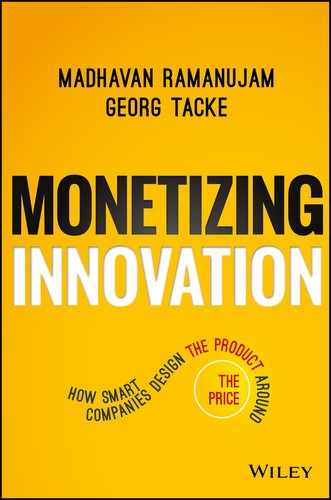Foreword
Innovation is my family business. My grandfather was a master electrician, master machinist, and inventor who came up with a new kind of fire alarm. My father is a physicist who worked day and night at the massive Bell Laboratories research and development facility in Murray Hill, New Jersey, which now has his picture at the door.
Growing up as a Bell Labs kid, I often wondered why these scientists, the smartest guys in the room for sure, were working in what looked and smelled an awful lot like a dungeon. Why weren't they rich and powerful? Of course, it may be that money and success weren't their goals, or there may be truth in the saying: Good at chess is bad at life.
But let me put it another way: Why don't all innovations become successful products? Why do so many fail?
This book has the answer.
Consider the way most companies turn ideas into products and services. They start by analyzing costs, a whole constellation of them: headcount, material inputs, machinery, tech requirements, infrastructure support, and on and on. They subtract these expenses from estimated revenues and out pops the expected profit. On that basis, the company places its bets.
But hold on: where did the revenue number come from? There was no careful scrutiny of detailed inputs. Generally, there was nothing more than an educated guess. That's a wild asymmetry of precision. It's even more reckless when you consider that the two elements—revenue and expense—are equally important in determining viability.
But it's much worse than that. With few exceptions, companies do not examine which features are important to the customer, and which are only important to the inventor. They do not know whether the customer wants one flavor, or a choice of many. They do not know if the customer will pay, wants to pay once, or will subscribe.
This is unfair to the innovator. The innovation team should know whether they are wasting their long nights on a concept that will go nowhere. They should know—as is often the case—when a change to the vision could dramatically increase its appeal. But that requires knowledge companies just don't have.
For the CEO, the executive team, and the R&D chief, this book lays out a battle-tested plan for getting back in control. It is based on the work that Simon-Kucher & Partners has done for hundreds of businesses, including my own. It's a straightforward plan, but not a simple one. Much of it counters the prevailing wisdom. There is no “move fast and break things,” but there is a lot of “look before you leap.”
It may be my bias, but I read it as a love letter to inventors—tough love in spots, but love nonetheless. Those scientists back at Bell Labs with Far Side cartoons taped to every door, the hard-working garage visionaries, the men and women of R&D teams everywhere, they all want the same thing. They want their ideas to come to life. They don't want them to die ignominious deaths on some back shelf.
And for my fellow corporate executives, this is a manifesto. I know of no other book that makes such a clear case for ensuring great new ideas will succeed, or that so clearly explains why we're wasting billions of dollars right now. Ironically, given the title, Monetizing Innovation isn't all about the money. Instead, as the authors would say, it's about going from “hoping” to “knowing.” It's about taking control of your company's future.
—Eddie Hartman
Co-Founder and Chief Product Officer of LegalZoom
January 2016
